
Bukhara is the seventh-largest city in Uzbekistan by population, with 280,187 residents as of 1 January 2020. It is the capital of Bukhara Region. The mother tongue of the majority of people of Bukhara is the Tajik dialect of the Persian language, although Uzbek is spoken as a second language by most residents.

Chagatai, also known as Turki, Eastern Turkic, or Chagatai Turkic, is an extinct Turkic language that was once widely spoken across Central Asia. It remained the shared literary language in the region until the early 20th century. It was used across a wide geographic area including western or Russian Turkestan, eastern or Chinese Turkestan, the Crimea, the Volga region, etc. Literary Chagatai is the predecessor of the modern Karluk branch of Turkic languages, which includes Uzbek and Uyghur. Turkmen, which is not within the Karluk branch but in the Oghuz branch of Turkic languages, was nonetheless heavily influenced by Chagatai for centuries.

The Chagatai Khanate, or Chagatai Ulus was a Mongol and later Turkicized khanate that comprised the lands ruled by Chagatai Khan, second son of Genghis Khan, and his descendants and successors. At its height in the late 13th century the khanate extended from the Amu Darya south of the Aral Sea to the Altai Mountains in the border of modern-day Mongolia and China, roughly corresponding to the area once ruled by the Qara Khitai.
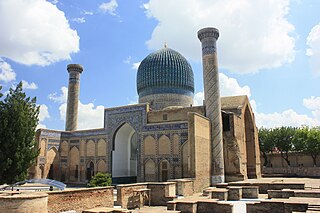
The Gūr-i Amīr or Guri Amir is a mausoleum of the Turco-Mongol conqueror Timur in Samarkand, Uzbekistan. It occupies an important place in the history of Central Asian architecture as the precursor for and had influence on later Mughal architecture tombs, including Gardens of Babur in Kabul, Humayun's Tomb in Delhi and the Taj Mahal in Agra, built by Timur's Indian descendants, Turco-Mongols that followed Indian culture with Central Asian influences. Mughals established the ruling Mughal dynasty of the Indian subcontinent. The mausoleum has been heavily restored over the course of its existence.

The Khanate of Khiva was a Central Asian polity that existed in the historical region of Khwarazm from 1511 to 1920, except for a period of Afsharid occupation by Nader Shah between 1740 and 1746. Centred in the irrigated plains of the lower Amu Darya, south of the Aral Sea, with the capital in the city of Khiva. It covered present-day western Uzbekistan, southwestern Kazakhstan and much of Turkmenistan before the Russian conquest at the second half of the 19th century.

The Khanate of Bukhara was an Uzbek state in Central Asia from 1501 to 1785, founded by the Abu'l-Khayrid dynasty, a branch of the Shaybanids. From 1533 to 1540, Bukhara briefly became its capital during the reign of Ubaydallah Khan. The Khanate reached its greatest extent and influence under its penultimate Abu'l-Khayrid ruler, the scholarly Abdullah Khan II.

Bayan Qulï was khan of the Chagatai Khanate from 1348 to 1358 and a grandson of Duwa.
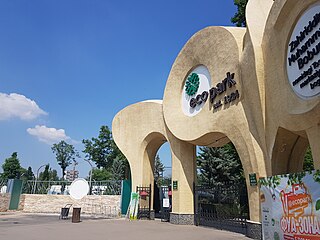
Tourist activities in Uzbekistan range from outdoor activities, such as rock-climbing, to exploration of its archeological and religious history. The Statistical Internet Survey conducted between May 7 and August 27, 2008, found that the majority of those surveyed (39%) visit Uzbekistan due to interest in its architectural and historical sites. The next-largest group (24%) visited Uzbekistan to observe its culture, way of life, and customs.
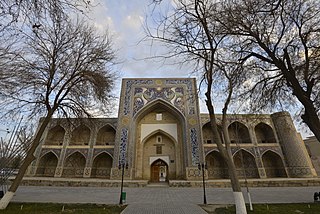
Lab-i Hauz, sometimes also known as Lyab-i Khauz, a Russian approximation, is the name of the area surrounding one of the few remaining hauz pools that have survived in the city of Bukhara, Uzbekistan. Until the Soviet period, there were many such pools, which were the city's principal source of water, but they were notorious for spreading disease and were mostly filled in during the 1920s and 1930s.

Sheihantaur, the mausoleum of Sheikh Hovendi at-Tahur, is an architectural monument in Tashkent, Uzbekistan.

The Mausoleum of Sheikh Zaynudin Bobo is located in Tashkent, Uzbekistan.
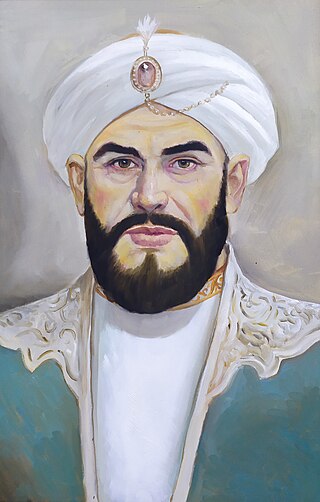
Abu al-Ghazi Bahadur was Khan of Khiva from 1643 to 1663. He spent ten years in Persia before becoming khan, and was very well educated, writing two historical works in the Khiva dialect of the Chagatai language. He was a descendant of Genghis Khan via Arab Shah.
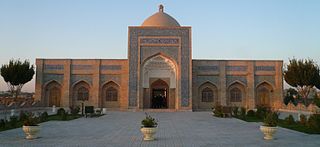
Bahoutdin Architectural Complex is a complex in Bukhara, Uzbekistan, that includes the tomb of Baha-ud-Din Naqshband Bukhari, the founder of the Naqshbandi order, who died in 1389. The ancient name of the location was Kasri Arifon.

Chor-Bakr is a memorial complex in the village of Sumitan at 5 km of Bukhara in Uzbekistan, built over the burial place of Abu-Bakr-Said, who died in the year 360 of the Muslim Calendar, and who was one of the four of Abu-Bakrs (Chor-Bakr) – descendants of Muhammad. The complex includes the necropolis of family tombs, and courtyards enclosed with walls.

Abū al-Maʿālī Sayf al-Dīn Saʿīd b. al-Muṭahhar b. Saʿīd Bākharzī (al-Bākharzī, Persian: باخرزی shortened as Sayf al-Dīn Bākharzī, was a poet, sheikh, and theologian who lived in the 13th century. As suggested by his nisba, he was born and raised in Bakharz, a district of the province of Quhistan in Khorasan, and he received his religious education in the cities of Herat and Nishapur. When he achieved unusual successes in mystical teaching, he moved to Khorezm. There he became one of nearest followers of very popular sheikh – Nadjm ed-Din Kubra. Afterwards, according to the prominent poet Abdurahman Djami Boharsi, Sheikh Saif ed-Din went to Bukhara as a tutor. In Bukhara he was honored with the title of "Sheikh al-Alam".
The Katagans are a medieval Mongol tribe related to Genghis Khan. In the period of Mongol conquest and assimilation with enslaved by Turkic tribes played its role in the ethnogenesis of modern Kazakhs, Kyrgyz, Karakalpaks, Uzbeks, Buryats, Uyghurs and others.

The Tomb of Shaykh Haydar is located in the city of Meshginshahr, Iran. It was first built in the 14th century during the Ilkhanate period, and later served as a mausoleum for Shaykh Haydar, the father of Shah Ismail I. It is number 184 on the list of Iranian national heritage monuments.
Subhan Quli Khan (1625–1702) was the sixth ruler of the Bukhara Khanate, who reigned from 1681 to 1702.
The High Middle Ages, or Classic Feudalism Period in what constitutes the present-day Republic of Azerbaijan, lasted from around the 11th century to the 15th century AD. The High Middle Ages were preceded by the Early Middle Ages and were followed by the Late Middle Ages, which ended around the 15thcentury AD. Key historical trends of the High Middle Ages include the incorporation of the territories that constitute present-day Azerbaijan into the Seljuk Empire, the establishment of the Eldiguzids, the Mongol invasions and the rule of the Ilkhanate, the invasions of Timur and the establishment of the Turkoman Kara Koyunlu and Aq Qoyunlu tribal confederations.


















